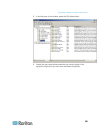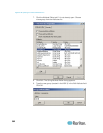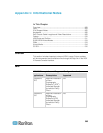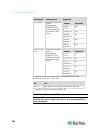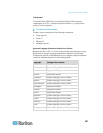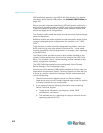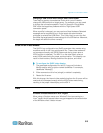
Appendix C: Informational Notes
308
Note: The Keyboard Indicator should be used on Linux systems using
Gnome as a desktop environment.
When using a Hungarian keyboard from a Linux client, the Latin letter U
with Double Acute and the Latin letter O with Double Acute work only
with JRE 1.6.
There are several methods that can be used to set the keyboard
language preference on Fedora
®
Linux clients. The following method
must be used in order for the keys to be mapped correctly from the
Virtual KVM Client and the Multi-Platform Client (MPC).
To set the keyboard language using System Settings:
1. From the toolbar, choose System > Preferences > Keyboard.
2. Open the Layouts tab.
3. Add or select the appropriate language.
4. Click Close.
To set the keyboard language using the Keyboard Indicator:
1. Right-click the Task Bar and choose Add to Panel.
2. In the Add to Panel dialog, right-click the Keyboard Indicator and
from the menu choose Open Keyboard Preferences.
3. In the Keyboard Preferences dialog, click the Layouts tab.
4. Add and remove languages as necessary.
Key Combinations and the Java Runtime Environment (JRE)
Because of a limitation in the Java Runtime Environment
™
(JRE
™
),
Fedora
®
, Linux
®
, and Solaris
™
clients receive an invalid response from Alt
Gr on UK English and US International language keyboards. Fedora,
Linux, and Solaris do not pick up events for the Alt Gr key combination
for Java
™
1.5. Java 1.6 appears to improve on this, although the
keyPressed and keyReleased events for Alt Gr still identify it as an
“unknown key code”.
Also, a key pressed in combination with Alt Gr (such as on the UK
keyboard Alt Gr-4, which is the Euro symbol), will only generate a
keyTyped followed by a keyReleased event for that value without a
keyPressed event. Java 1.6 improves upon this by filling in the
keyPressed event as well.




